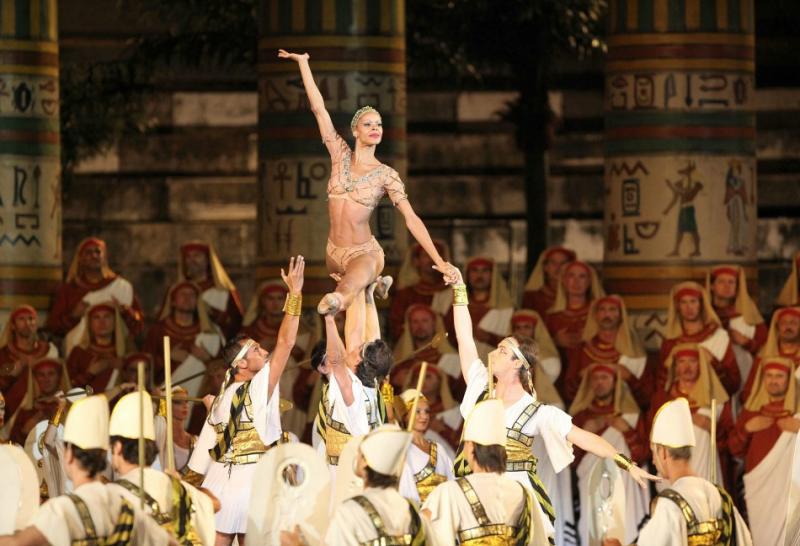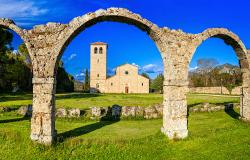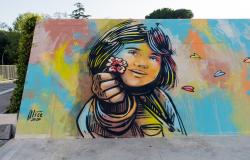BACKGROUND
Aida is a four-act opera written by Verdi to an Italian libretto by Antoni Ghislanzoni, which was based on a scenario by French Egyptologist Auguste Mariette (although the latter attribution has been questioned – for example, it has also been suggested that the scenario came from Temistocle Solera).
Initially, Aida was set to première earlier in 1871, after a commission from Isma'il Pasha, Khedive of Egypt. However, the Franco-Prussian war delayed this by months.
Auguste Mariette was heavily involved with the realisation of the project. He helped to design the costumes and accessories, and also led the designs and construction of the sets. Interestingly, two sets of designers put together the sets for two sets of acts. The sets for acts one and four were put together by Philippe Chaperon and Auguste Rubé, for acts two and three, sets were provided by Edouard Despléchin and Jean-Baptiste Lavastre.

FIRST PERFORMED
24th December 1871 at the world première in Cairo. The European première took place a couple of months later on 8th February 1872 at La Scala, Milan. Verdi himself is said to have regarded the latter as the “real” première, having allegedly been dissatisfied with the fact that no members of the general public were invited to the Cairo première (which instead comprised guests from higher walks of life such as dignitaries and politicians).
It's also worth noting that Verdi is said to have written the central part of Aida for his close friend Teresa Stolz. Stolz, in fact, did not perform at the Cairo première (the role of Aida was played by Antoinetta Anastasi-Pozzoni), but did perform at the Milan première.
NOTABLE PERFORMANCES

24th December 1871: Khedivial Opera House, Cairo, Egypt
8th February 1872: La Scala, Milan, Italy
26th November 1873: Academy of Music, New York City, United States od America
12th December 1874: Teatro Real, Spain
23rd November 1875: Great Theatre and Polish National Opera, Warsaw, Poland
22nd April 1876: Theatre-Lyrique Italien, Salle Ventadour, Paris, France
22nd June 1876: Royal Opera House, Covent Garden, United Kingdom
6th September 1877: Royal Theatre, Melbourne, Australia
THE PLOT

Aida revolves around its eponymous character, an Ethiopian princess who is captured and made into a slave in Egypt. No particular period is given, although the story takes place in the Old Kingdom (which is the third millennium BC – the era between the third and sixth dynasties, 2686 – 2181 BC).
The action plays out against conflict between Ethiopia and Egypt. Both sides are at war, but principal characters between both sides find that they have come together – most notably, Aida and the Egyptian military commander, Radamès, who has fallen in love with Aida. Initially, Aida keeps her real identity a secret.
Radamès, in turn, is adored by Amneris, the daughter of the Egyptian king. However, the feeling is not a mutual one, and Amneris even suspects that this is the case. Suspecting Aida, she tricks the Ethiopian princess into declaring her true feelings after falsely claiming that Radamès has died in combat.
After Radamès returns successful from battle and a hero, the king says that he can have anything he wishes. However, his request for the release of Aida and her father Amonasro (now hostages) is denied. Instead, the Egyptian king proclaims that Radamès will be wed to his daughter and will be a successor to the throne.
However, Radamès arranges a clandestine meeting with Aida (who has been instructed by her father to locate the Egyptian army). He not only suggests a safe route of escape, but also the location of the Egyptian army to Aida. Radamès is found with the enemy and is promptly captured and sentenced to death. Despite Amneris' pleas for mercy, Radamès is still taken to a vault in which he is to be buried alive. However, Aida is waiting there for him, and shares his death.
THE CHARACTERS

Aida – An Ethiopian princess, who becomes a captive and slave in Egypt after the two countries become embroiled in war. Aida finds herself falling in love with the Egyptian military commander, Radamès. Aida finds herself torn between her love for Radamès and her home country and father.
Radamès – The heroic Egyptian military commander, who wages a successful campaign against Ethiopia. A national hero, he is granted anything he desires by the Egyptian king, although the true object of his desire, Aida is someone that he can never have, because she is from the opposing country. Despite an arrangement of succession to the throne and marriage to the king's daughter, Radamès still finds himself in love with Aida and vows to escape with her.
Amneris – The daughter of the Egyptian king. In love with Radamès, even though the feeling is not reciprocated. Not above underhand tactics to win round Radamès – for example, in a scene with Aida, she tricks the Ethiopian princess into thinking that Radamès is dead, in order to get Aida to profess her true feelings for the commander.
The King of Egypt – A proud, noble ruler and father of Amneris.
Amonasro – The king of Ethiopia and father of Aida. Is also taken captive by the Egyptian troops, although he keeps his identity a secret after tricking the Egyptians into thinking that he has died in battle.
Ramfis – The high priest.
ANALYSIS

Aida is one of Verdi's best known and best loved operas. It encompasses all of Verdi's main signatures – human drama; conflict; subtle and effective use of music; and of course an ending of Shakespearian proportions.
On the surface, Aida is a big, swaggering epic, telling the story of conflict between Ethiopia and Egypt. The character of Radamès is a strong, noble, heroic warrior, who helps to win the battle and return a victor to the promise of succession to the throne. However, beneath the fighting, Aida is a much more personal tale that examines the conflicts of human emotion. The physical fighting between two factions is juxtaposed by the emotional conflict that both Aida and Radamès experience. Both characters are drawn to each other – but the problem is that love is forbidden. How can Aida fall in love with someone who is on the opposing side and vice versa? So it's that very conflict that gives the Aida opera its real edge. Love vs duty. Love vs patriotism. Love vs honour. Battles in which no happy ever after ending is guaranteed.
Brimming with human passion, Aida sees many of its characters wear their hearts on their sleeves. Amneris is very much the jealous woman scorned by Radamès' love for Aida. She uses duplicitous, underhand tactics to force the truth from her rival to the point where she tricks Aida into thinking that Radamès is dead. It's also Amneris who finds Radamès with Aida and raises the alarm. The irony is that in doing so, she starts the chain of events that lead to the final fate of Radamès.
Amonasro is also very much a passionate man, and in this case, that passion is fuelled by a love of his country. He cannot bear the thought of his daughter falling for an Egyptian warrior, and in the third act, he denounces his daughter, casting her off as a slave of the pharaohs.
Musically, Verdi pulls off the successful trick of reflecting the conflicting emotions of the story in the conflicting styles of music – for example, the quiet reflective string motif for Aida is in stark contrast to the ominous, moody theme for the priests – or in the Celeste Aida segment, in which the music is one minute dramatic and heroic, and the next, it's softer and more reflective.
Aida is one of Verdi's greatest triumphs, telling a story packed full of human drama and tragedy, with a hugely effective ending that delivers a real sting in the tail.












